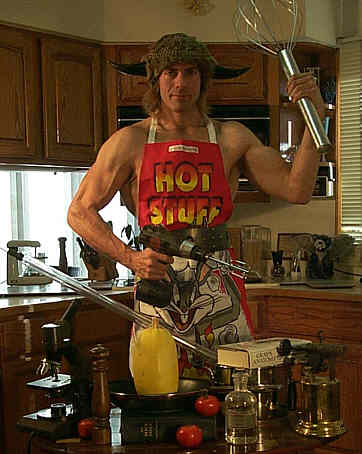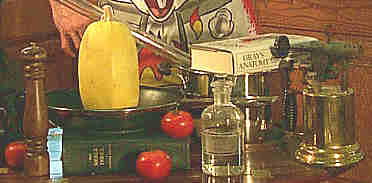
Cooking with the Norwegian Chef
Quick, easy,
low-calorie,
high-protein
("bork, bork")
Okay, truth be told, my cooking style and mien are a lot more like Gonzo or Doctor Bunsen Honeydew, but they never got a cooking show; at least not one where the live studio audience survived unscathed. But I'd gotten a request to put up something with the horned helmet and the more serious costume I'd had in mind is one that's still "in the shop." (Oh, and I don't have the red shorts on under the apron, in case you'd wondered....)
One of the questions that comes up a lot on the fitness and diet groups
is "what are some high-protein, low-calorie foods that are quick, easy,
and still pleasant to eat?"
These aren't recipes as much as they are
general themes and thoughts about what I happen to like. All
of what I've got here is suitable for
lacto-ovo-vegetarians, but I'm sure you could add meat-type-things if
you wanted.
-
One of my favorite quick-and-easy meals is to make something that's sort of like lasagne, but with vegetables instead of pasta and it's also a lot quicker and easier. This kind of approach works with a lot of pasta-based recipes; I've come to think of pasta as being just calories that come in different shapes and that ingredients which do have flavor and nutritional value can stick to. A lot of vegetables have more interesting flavors and textures of their own and work very nicely when used where you'd otherwise use pasta of some sort.
-
To make one really big serving or a couple of little ones, I start
out with about half a pound of frozen vegetables--usually some
interesting vegetable mix including broccoli (but I'm especially
fond of that particular vegetable, so I manage to sneak it into a
lot of things).
Thaw for around three minutes in the microwave, chop and add any quick-cooking fresh veggies you've a mind to--tomatoes, mushrooms, pea pods, etc., or none at all--add 3-6 ounces of shredded or finely cubed nonfat or lowfat cheese, sprinkle with spices to taste. I use a healthy shaking of "Italian Spice Blend" because I'm lazy and then either crushed red or jalapeno pepper because I like some heat in this recipe; when the mood strikes, I'll also toss in garlic, minced or powdered onion, chives, or whatever seems appropriate and I have on hand.
Toss together until the spices coat the various vegetable and cheese pieces reasonably evenly and pour enough spaghetti sauce or other tomato-based sauce over the top to cover.
Cover this so it doesn't spatter or dry out--with the bowls that I use, I have a Pyrex pie pan that fits right--and microwave for another six to eight minutes. If I have some, I dump a bit of "nonfat" parmesan on top, and that's it.
One of the good things about this recipe and a lot of Italian-style recipes in general is that it's just as good reheated, so I can make a big batch, eat as much as I feel like at the time, and then warm the rest up later when I'm hungry again.
-
Lazy cooking tip:
I usually buy the Healthy Choice low-fat cheese balls; according to the label, 30g (a little more than an ounce) has 1.5g of fat, 9g of protein, and less than 1g of carbohydrate. The easy way to use cheese in recipes like this is, instead of grating it, to cut several slices, pile them in a stack, cut lengthwise into strips, turn cutting board, and cut crosswise into little cubes. At least for me, it takes far less time than grating, I don't have to clean up the grater afterwards, and I never end up grating my fingers into the recipe (which would probably be more of "the personal touch" than most people would really like to experience--or maybe it would be worse if I did that and they developed a taste for it...).
One traditional source of low-calorie protein is egg whites or any of the various "nonfat egg substitutes" (basically egg whites and yellow food coloring, but they are definitely easier to use than separating a bunch of eggs.
-
No matter how big a "Rocky" fan you are, it's really not a great idea to drink them raw--the various "egg substitutes" are pasturized so at least you wouldn't be risking salmonella by gulping down those, but uncooked egg whites still contain avidin which will combine with biotin and prevent its absorbtion when you eat it, but that's inactivated by cooking.
So, egg whites are a good basic protein source, and now you just want to add some excitement--one of my current favorites is to chop up "Smart Dogs" (a high-protein, low-fat (and even low-carb) vegetarian "hot dog") and fry them a bit, add chopped onion and the results of the spice-urge-of-the-moment (black pepper, sometimes chopped or powdered jalapeno or red pepper, and so forth), cook for a bit, then just pour the eggs over it all and stir it up until it's all cooked.
I usually use one or two whole eggs and then a fair amount of the "egg substitute" ('cause I'm lazy and the store brands are pretty cheap); I figure that egg yolks contain some perfectly fine nutrients, but they do have a lot of fat too, and so I just don't use a lot of the yolks. You can add all sorts of other things--raw mushrooms or tomatoes, for example, work just fine, though they'll add a bit more moisture to the eggs while they're cooking.
If you've a mind to, you can also top with melted cheese, salsa, or even hot sauce if you're looking for a bit of variety.
-
On one of my low-carb periods, I ran across a kind of cracker called "Wasa Fiber Rye"; one cracker--about the size of a graham cracker--has 1g fat, 4g carbohydrate, 2g fiber, and 1g of protein. Some people think they taste like cardboard, but I like them.
-
One thing about them, though, is that they're crunchy and, when eaten with a slice of cheese for protein (like a slice of the the Healthy Choice cheeseball I'd mentioned above), the combination of protein and fiber feels pretty substantial and keeps the hungries away pretty well. A lot of people get hungry right away again when they snack on sugary snacks or just carbs alone, but a crunchy bit of protein and fiber gives you a slow, long-lasting release of nutrients to help keep you feeling happy, alert, and satisfied whether you're trying to get ready for that upcoming competition or just get back into the next smaller jeans size (and one of your coworkers has just brought in three dozen glazed doughnuts and assorted eclairs with extra frosting).
-
And speaking of protein, dieting, and the occasional urge to eat everything in the fridge, it's my own experience that there's only so much protein you can eat, but sugar can be gobbled in unlimited amounts.
-
At least for me (and the biochemistry issues behind this are best left for another section), I find that sugar increases hunger, not just when eating it, but in general. It's not the sweetness--because artificial sweeteners don't have this effect--and interestingly enough, straight dextrose (also known as glucose) also doesn't have this effect--in fact, there's only so much glucose I can eat before I get a pretty strong "okay, that's plenty; please stop now" feeling.
Like I said, I'll leave the biochemistry of fructose metabolism ramblings for another section, but I do find that the fructose content seems to be the operative factor at least for me. Keep in mind that, contrary to popular belief, fruit isn't all that high a source of fructose--table sugar is half fructose and anything (like soda pop) sweetened with high-fructose corn syrup is much more concentrated. Fruit does contain fructose, but it has a lot of other sugars and starches and even some nutritional value--whereas processed foods that are sweetened with sugar (sucrose) or high-fructose corn syrup pack a whole lot more fructose into a compact food item.
Lately I've been making sugar-free instant pudding and adding protein powder to it. It's sweet, it's a good post-workout or post-biking snack, but unlike a sugar-filled low-protein pudding, you can't eat all that much of it without feeling reasonably filled. Current research would suggest, incidentally, that endurance athletes generally experience a higher protein turnover rate than strength athletes, so higher protein intake may actually be more important to the training of a marathon runner or triathlete than a bodybuilder or powerlifter. In any case, sugar-free pudding mix and protein powder are pretty darned close to what you find in special sports-oriented "meal replacement drinks," but it's cheaper and you can adjust the ingredients to fit your tastes. (There's a little more about that on the Underwear, scotch tape, and "Lite Salt" page.)
-
I figure I'll add more to this page with time--there's a lot of things I make that would fit in this section, but, like most of my cooking, there's no recipe per se, I've just done enough experimentation for myself that I have a general idea how to make various random creations that I like. I'll work on trying to watch what I'm doing closely enough to come up with some recipes, so stay turned....
|
Trygve.Com sitemap what's new FAQs diary images exercise singles humor recipes media weblist internet companies community video/mp3 comment contact |
